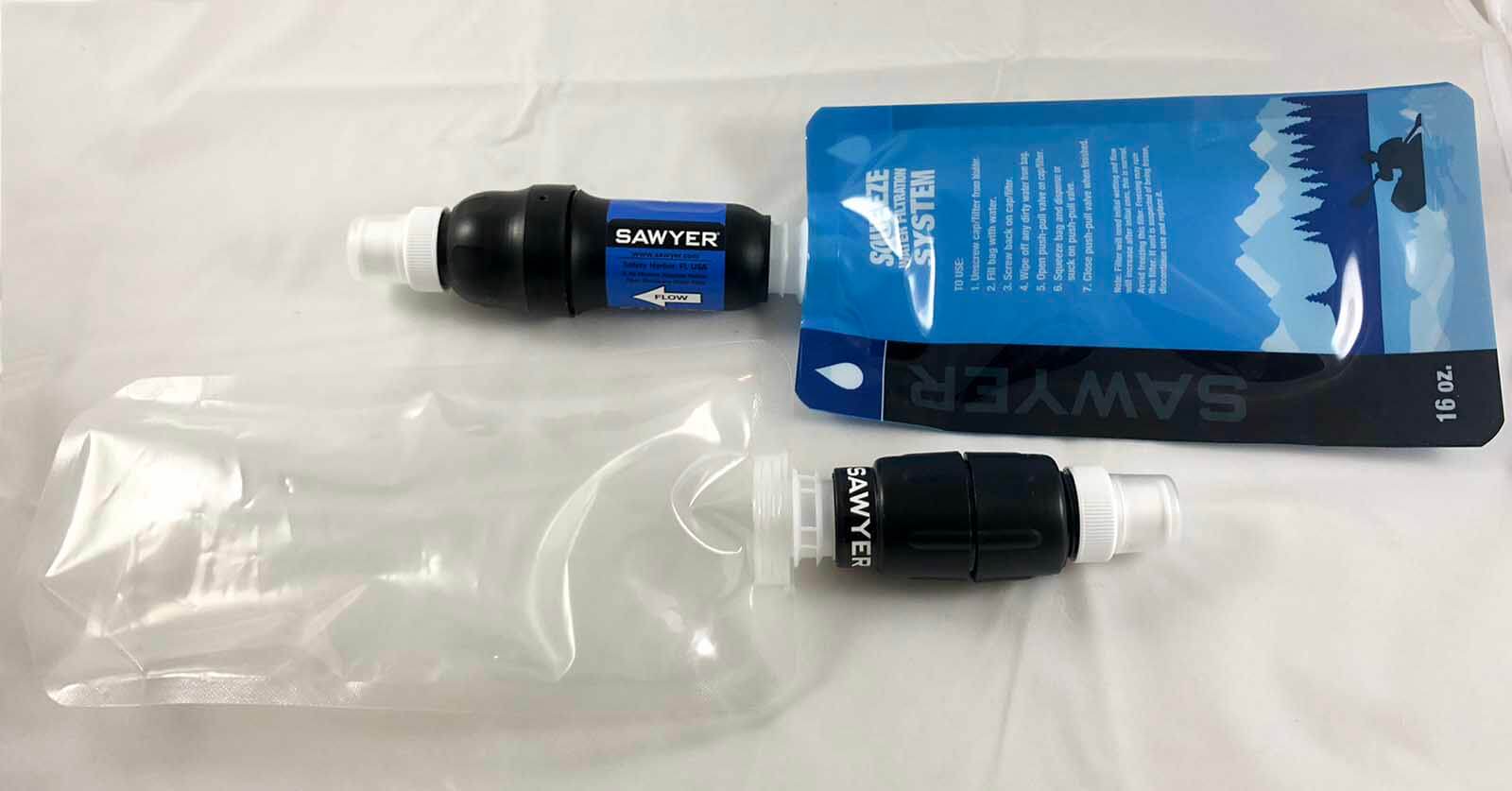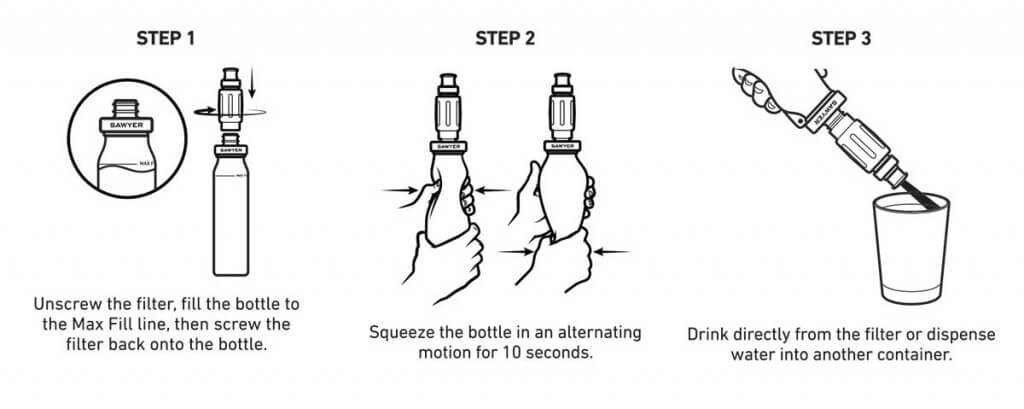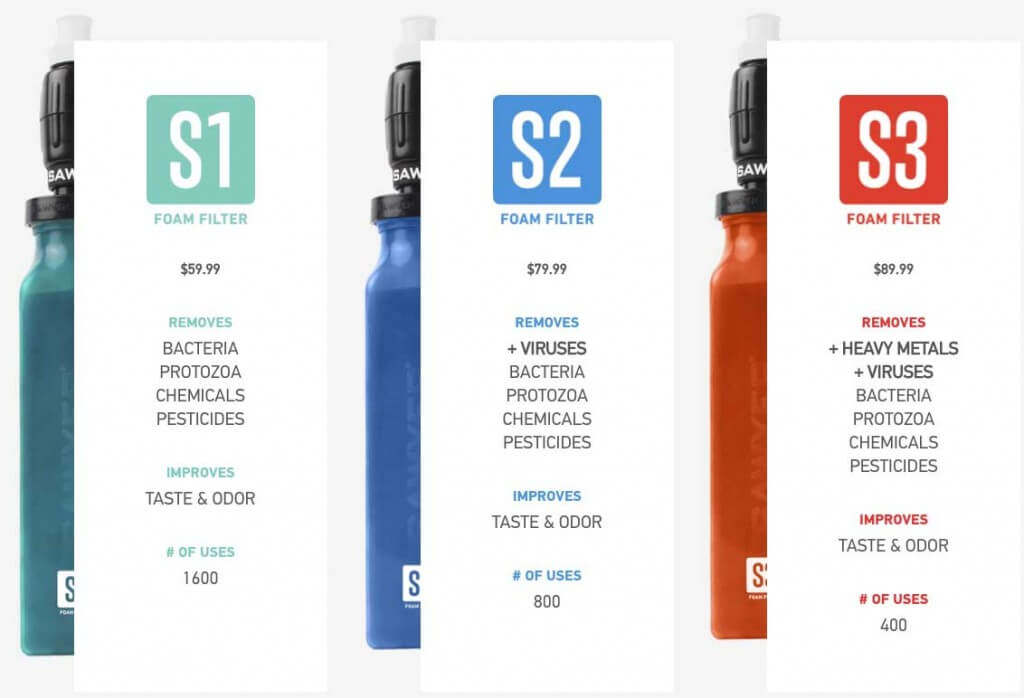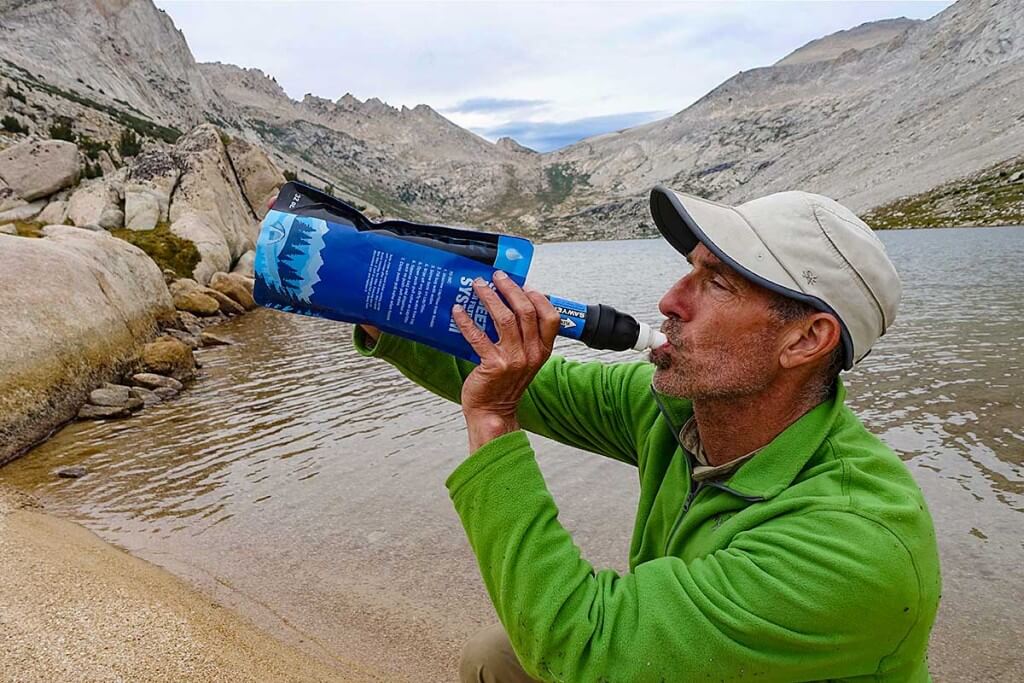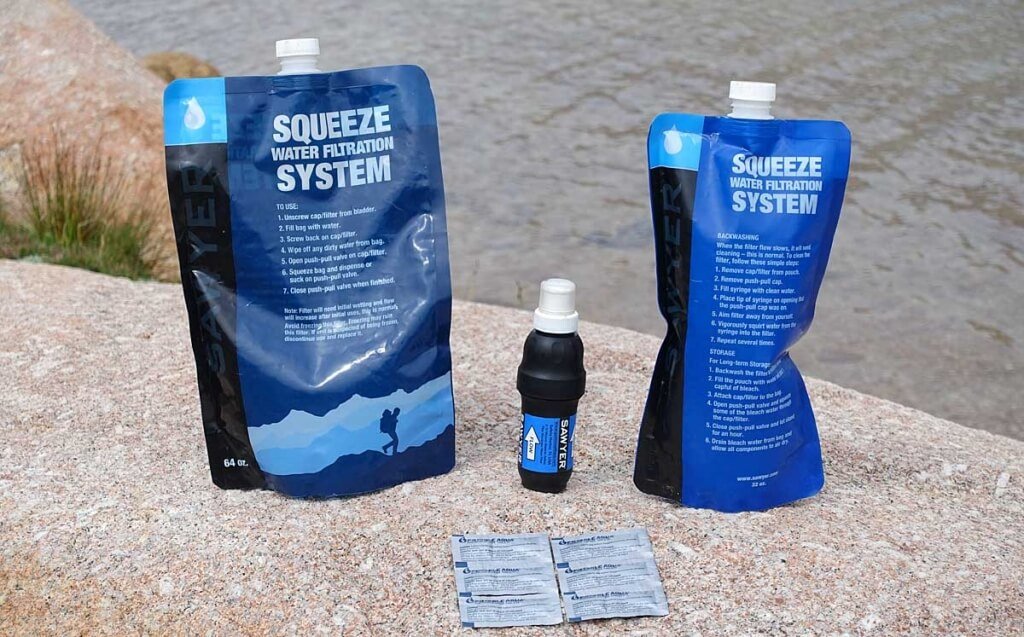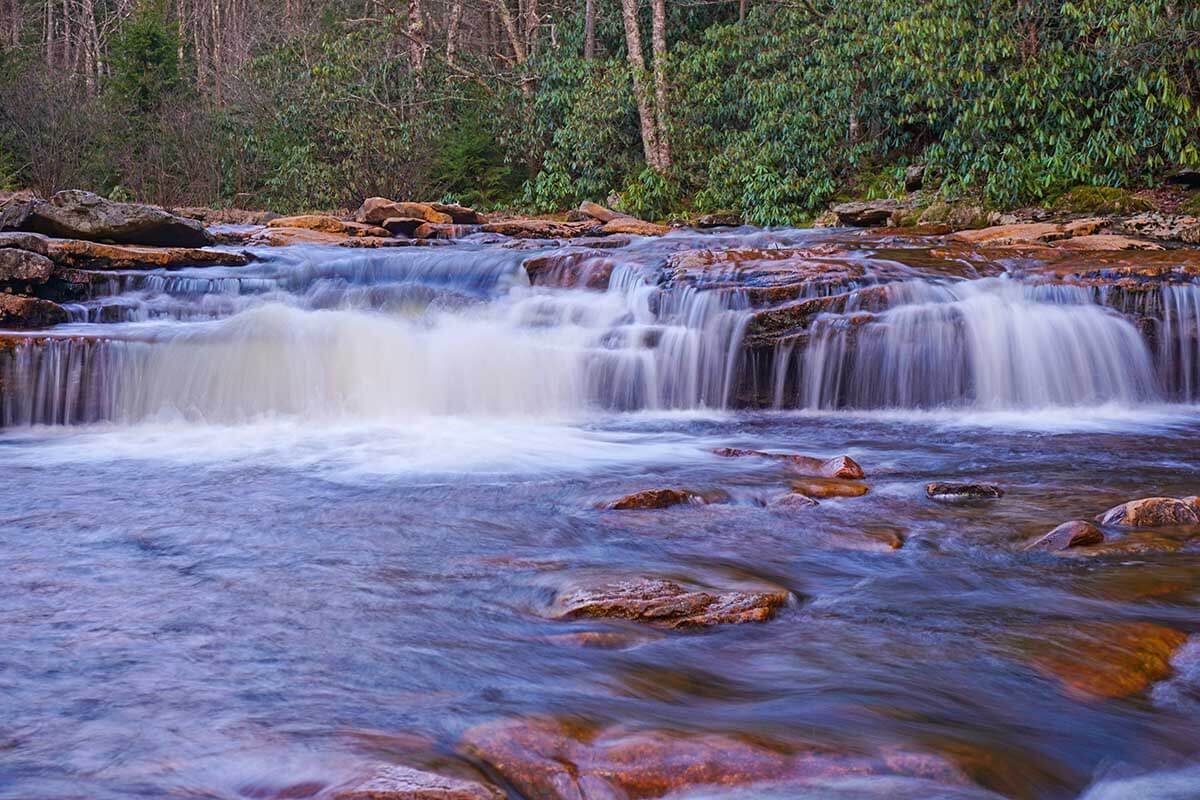We will help you choose the most effective hiking water bottle for your ultralight backpacking needs. Hard and soft-sided options.
Sawyer introduced three items that should make the best water filter system on the market even better. The new mid-sized Sawyer Micro Squeeze Filter with the new squeeze pouch is 1/2 the weight of the full-sized Sawyer Squeeze filter with the old squeeze pouch. According to my scale (1.85 oz) the new Micro Squeeze Filter is even lighter than the 2.0 oz Sawyer Mini Filter.
And likely a game changer for Sawyer. They introduced a “Bottle Breather” that will make it easy peazy to drink from a filter mounted on a Smart Water bottle. Users of the ubiquitous Glaceau Smart Water bottle should be delighted!
Bottom of pic above: The new mid-sized Sawyer Micro Squeeze Filter with the new squeeze pouch. Top of pic: full-sized Sawyer Squeeze filter with the old squeeze pouch. The new system is 1/2 the weight for almost the same performance.
Quick Specs
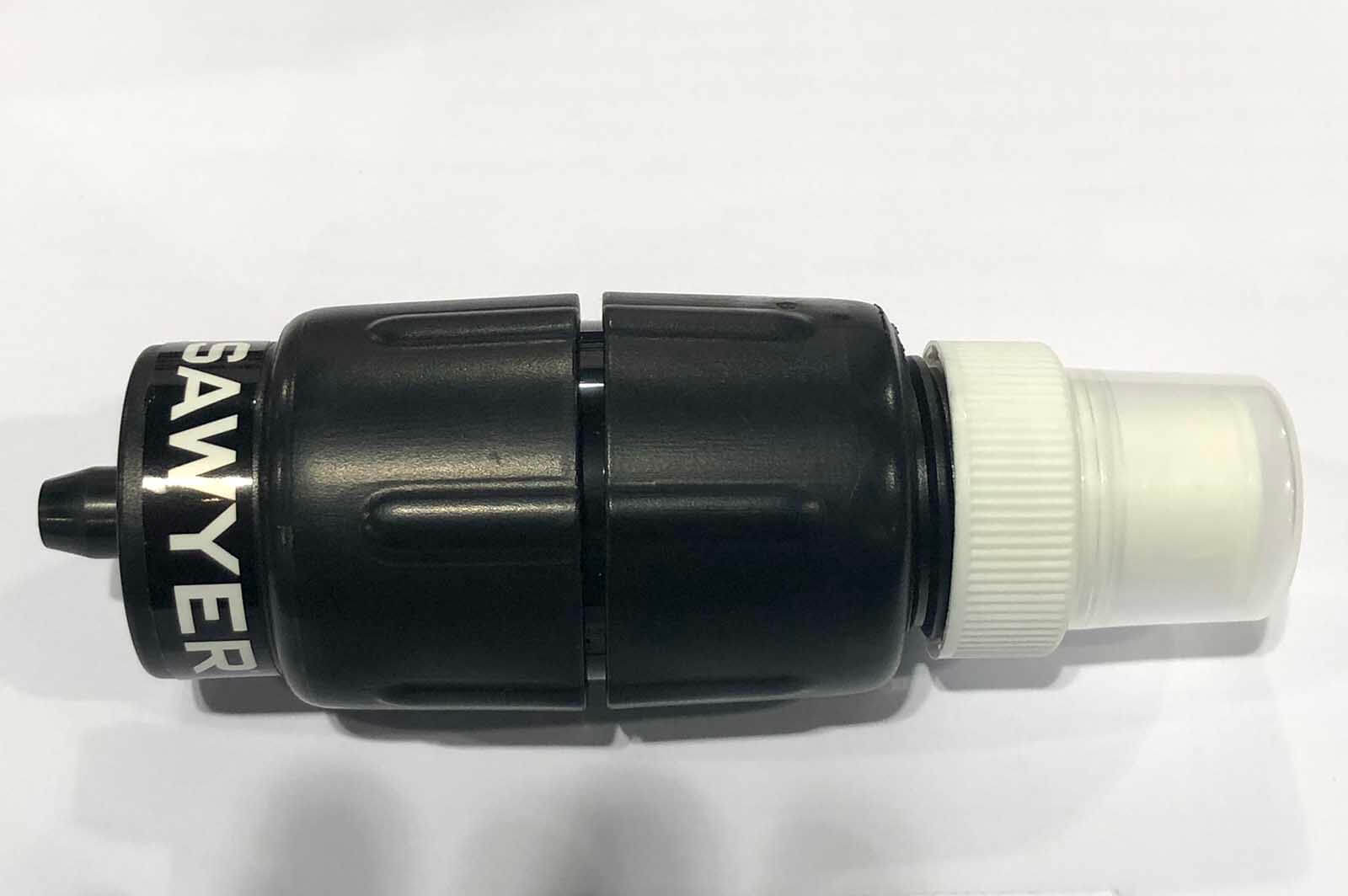
The new Sawyer Micro Squeeze Filter is 1/2 the weight of the larger, workhorse Squeeze Filter while retaining many of its more desirable features like a higher flow rate and less tendency to clog (vs. the Sawyer Mini Filter).
1. New Sawyer Micro Squeeze Filter 1.8 oz (52g) – This new filter hits the sweet spot between the very small Sawyer Mini Filter (lower flow rate & more prone to clogging) and the much larger, full-sized Squeeze (the Thru Hiker workhorse in the Sawyer line). Due to its larger diameter, the Micro Squeeze should have a higher flow rate than the Sawyer Mini Filter and be less prone to clogging. In addition, the new Micro Squeeze is far less cumbersome when attached to the end of a squeeze pouch or the ubiquitous Glaceau Smart Water bottle that many backpackers use.
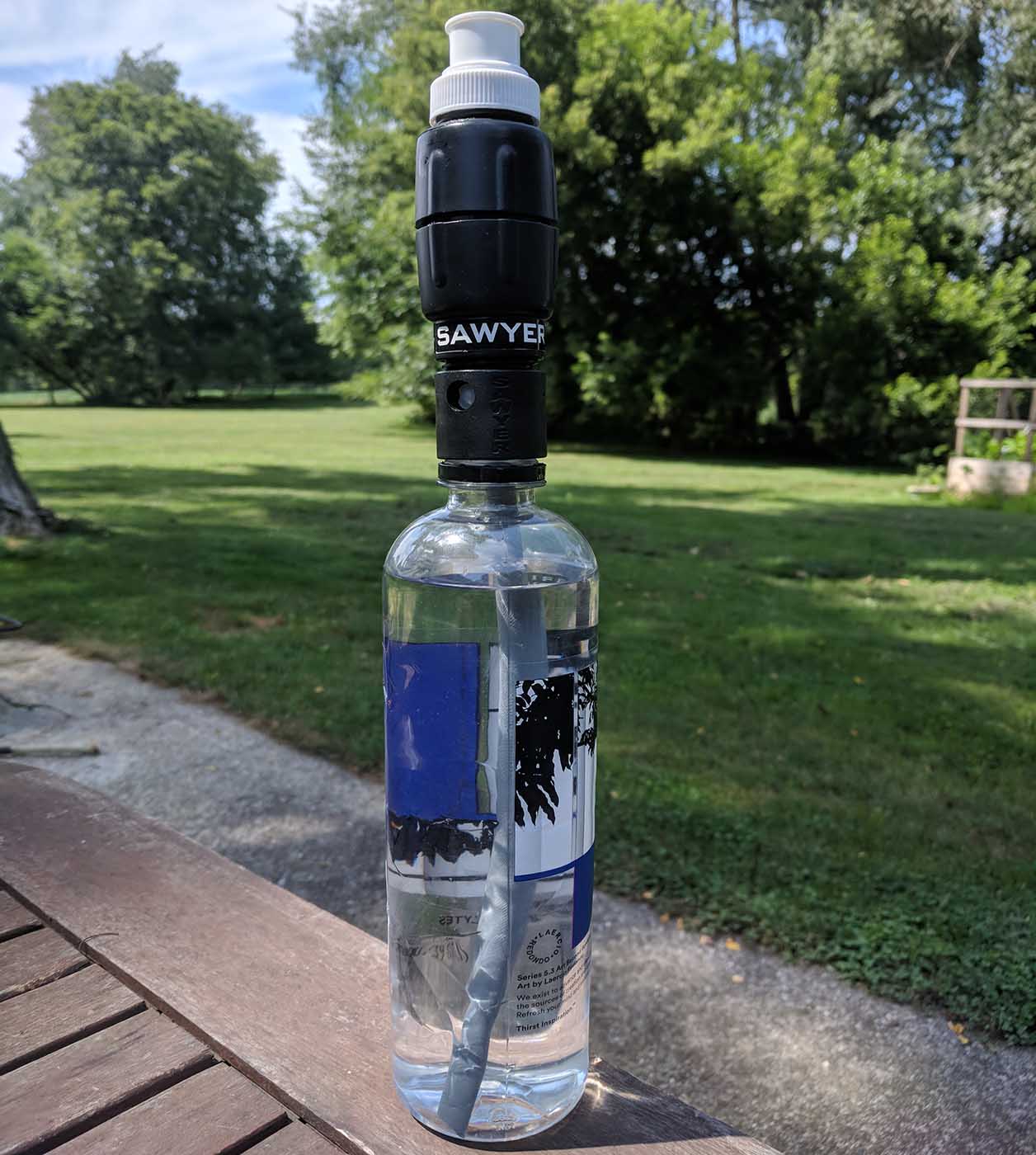
New Bottle Breather: A game changer for Sawyer and great news for Smart Bottle users! Shown in picture top to bottom – New Sawyer Micro Squeeze Filter, new Bottle Breather, and its cut-to-length tubing. All are mounted on the ubiquitous Glaceau Smart Water bottle.
2. New Bottle Breather 0.5 oz (less tubing) – This will be game changer for Sawyer and great news for Smart Bottle users! When you are drinking from a rigid water bottle (e.g. Glaceau Smart Water bottle) the new Sawyer Bottle Breather allows air to enter the bottle as you drink. This keeps the sides of the bottle from collapsing in and means that you don’t have to take your mouth off of the filter to “burp” more air into the bottle to continue drinking. The Bottle Breather comes with cut-to-length tubing (a straw). Note: this system works best when used with the bottle in a vertical position. [I expect to get a post-Outdoor Retailer Show test version of this soon.]
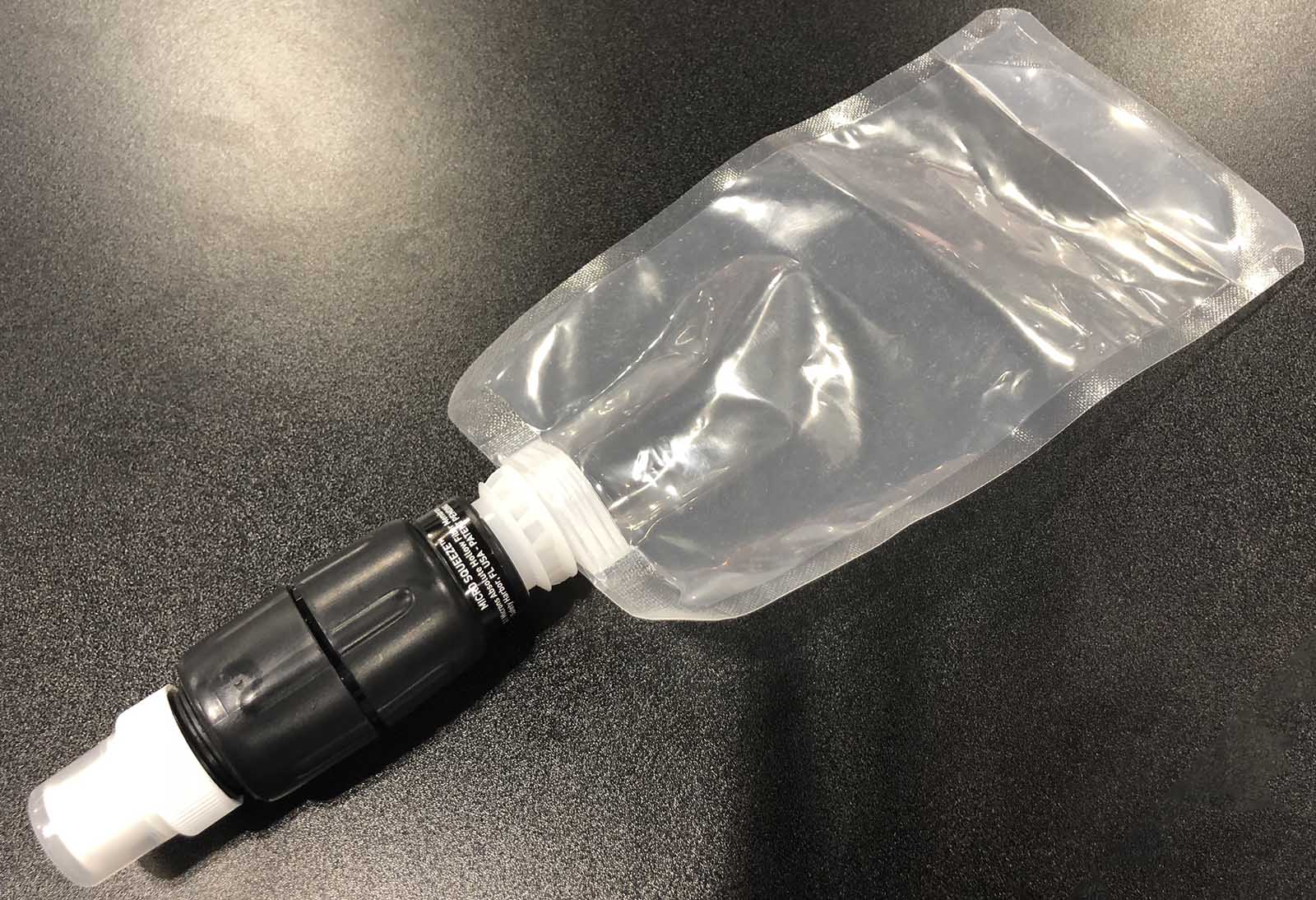
The new mid-sized Sawyer Micro Squeeze Filter with the new squeeze pouch is 1/2 the weight of the full-sized Sawyer Squeeze filter system.
3. New squeeze squeeze pouch 0.50 oz, 1 L size – Sawyer’s new squeeze pouch is 1/2 the weight of the old squeeze pouch, but just as strong. The pouch also has a new bottom gusset so the pouch fills easier and stands easier. The pouch uses a new proprietary polymer that Sawyer engineer John Smith declined to elaborate on. [Note: the pre-production pouch in this picture is clear. The new production pouches will be opaque (not clear), similar to current pouch design.]
Conclusion
I see the Micro with Bottle Breather as a game changer for fast, effective, hassle free water filtration for backpackers and hikers. This new system will easily fit in the side pocket of a backpack — quickly providing safe drinking water without the need for chemicals. In addition, a rigid water bottle is much easier to fill than the soft-sided squeeze pouches.
A lighter and lower cost alternate to the full-sized Squeeze Filter that has the full pop top bottle cap and higher flow rate (than Sawyer Mini Filter) will be appealing to hikers and backpackers that don’t beat the crap out of their gear for weeks or months on end. In addition, the new Micro Squeeze Filter is less bulky and cumbersome when mounted on the top of a Smart Water bottle or squeeze pouch.
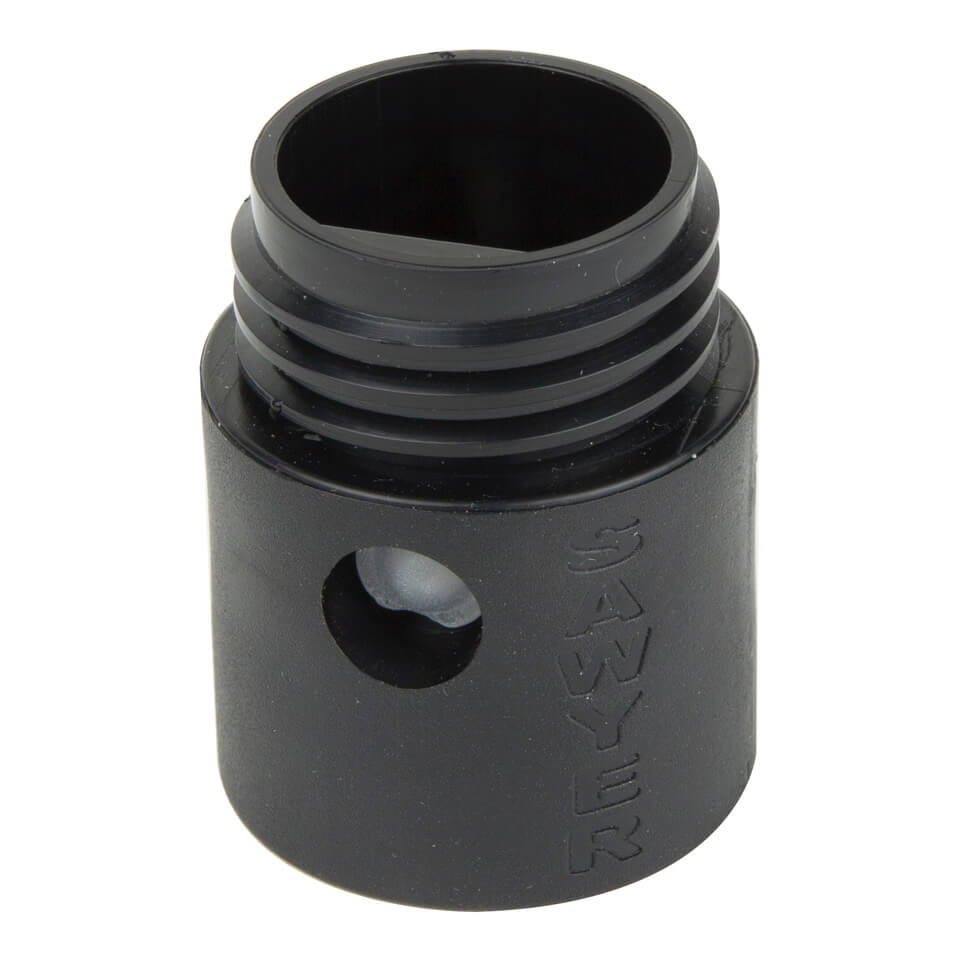
Close up detail shot of the new 0.5 oz Bottle Breather for Sawyer Micro Squeeze Filter
Disclaimer
This post contains affilate links. If you make a purchase after clicking on the these links, a portion of the sale helps support this site at no additional cost to you. I do not receive compensation from the companies whose products are listed. For product reviews: unless otherwise noted, products are purchased with my own funds. I am never under an obligation to write a review about any product. Finally, this post expresses my own independent opinion.
Viruses, pesticides & harmful chemicals in water are a concern for international hikers, and even areas in the US! Sadly, until recently there were no inexpensive & lightweight water purifiers that could handle all these contaminates. But a few months ago Sawyer solved this dilemma with their new Sawyer Select S2 Water Purifier Bottle. It removes viruses, bacteria, protozoa, harmful chemicals, and pesticides. Best of all, it does this in an inexpensive and easy to use bottle weighing only 10 ounces.
What’s Great About It
The combination of removing protozoa, bacteria, and viruses and pesticides, and other harmful chemicals (and even heavy metals like lead & mercury) is what sets the Sawyer S2 and S3 purifiers apart from all others. Few if any purifiers can remove all these contaminants, and certainly not at their low cost and weight. And surprisingly, you can start drinking purified water in just 10 seconds. It’s that easy!
The Sawyer Select S2 Water Purifier Spec’s
- Removes 99.99% of viruses, 99.99999% of bacteria, 99.9999% of protozoa, cysts, chemicals & pesticides
- Reduces chemicals to 0.5 parts per billion, up to 40 times lower than the EPA’s maximum rec. level
- Reduces pesticides to 0.01 ppb, up to 400 times lower than the EPA’s maximum rec. level
- Weight dry: 9.2 oz (260 g) on my scale — wet after use 13.0 oz (270 g)
- Time to treat 10 sec. Time to drink from bottle immediate. Time to squeeze ~30 sec. for 20 oz capacity.
- Cost: $80 at REI
Note: The S2 Purifier has only been out a few months. As such this is an initial/short term review . Longevity and long term use has not yet been tested/determined.
Compared To the Sawyer Squeeze System
Sawyer Squeeze Filter (and Sawyer Mini)
The Sawyer Squeeze Filter (and Sawyer Mini) both eliminate protozoa and bacteria. But they don’t eliminate viruses, chemicals, pesticides, or heavy metals. And they don’t improve the taste or odor of the water. The Sawyer S2 eliminates all of these with the exception of heavy metals. (You have to upgrade to the S3 for heavy metal removal.) On the plus side, the Sawyer Squeeze has a much longer useful life, is much lighter, and costs less than the S2.
TIP: Soon you can convert your current Sawyer Squeeze Filter into a Sawyer Select S1, S2, or S3 Purifier by purchasing just the bottle and foam. This will save you $15 over the full system. [bottle & foam only option currently not available but Sawyer says they are coming soon] See more here…
Compared To Other Purification Methods
Pump Water Purifiers that remove viruses
Pump Filters that remove viruses like the MSR Guardian Purifier are quite expensive and heavy ($350 and over a pound). And even then the MSR Guardian Purifier does not eliminate chemicals, pesticides, or heavy metals. Note: most other less expensive pump water purifiers also do not eliminate viruses in addition to not removing chemicals, pesticides, or heavy metals. E.g. the bestselling MSR SweetWater Microfilter Water Filter and Katadyn Hiker Pro Clear Microfilter.
Chemical water purification
Chemical treatments don’t eliminate harmful chemicals, pesticides, or heavy metals. They are also not 100% effective in turbid water. The Sawyer Select S2 Water Purifier Bottle is much faster. Water is purified & drinkable in 10 seconds. In comparison, chemical treatments can take up to 4 hours to fully purify water. And you have to carry that water around with you until it’s fully treated. That means you’ll unnecessarily carry 2 to 6 pounds of water in your pack. Finally, chemical treatments leave a taste & some hikers don’t like introducing chemicals into their body.
UV Sterilization
UV sterilization e.g. the SteriPEN eliminates protozoa, bacteria, and viruses in a few minutes. But it doesn’t eliminate chemicals, pesticides, or heavy metals. Another downside: UV pens don’t have a good reputation for battery life & treatment capacity in the field. Finally, UV doesn’t work well with muddy, turbid water. In this case, you’ll have an added step of pouring your water through a pre-filter before using the SteriPEN.
How Does the S2 Work?
A new proprietary Adsorption Technology Foam1 is the key to the Sawyer Select S2 Water Purifier and is what sets it apart form the competition. The S2 Water Purifier consists of three main parts:
- Flexible silicone bottle that holds proprietary adsorption foam.
- Adsorption Foam Purifier Material1. This proprietary adsorption foam is the first stage of purification. It does almost all of the removal of harmful chemicals, pesticides, and viruses (e.g. Hep A, Hep E, Rotavirus, etc.).
- Micro Squeeze Filter2 on top of the bottle. This is the second stage of purification. It removes bacteria (e.g. E coli, typhoid fever, cholera, etc.) and protozoa (.e.g giardia, cryptosporidium. etc.); as well as particulate matter & sediment.
1 The proprietary Foam Adsorption Technology used in Sawyer Select S2 Water Purifier (and S1 and S3 filters) was developed by a partnership between Sawyer and Foamulations LLC . It safely removes contaminants like chemicals, pesticides, and viruses (and heavy metals – S3 only). Adsorption filtration is the process in which harmful chemicals and viruses adhere to the surface of the adsorbent foam membrane. They are permanently captured (adhered to the foam) and neutralized.
2 The new Micro Squeeze Filter is the same diameter and the same flow rate as the Sawyer Squeeze Filter but is shorter and lighter. It uses the same 0.1 micron “Absolute Hollow Fiber Membrane.”
How to Use the Sawyer Select S2 Water Purifier
TIP1: The only thing I would add to these instructions is to use something like a widemouth 20 or 24 oz sports drink bottle to accurately pour water into the 0.75″ diameter opening of the S2 bottle. This 1) makes it easier to collect the water from a stream or lake. And 2) it allows you to make a clean pour without having any contaminated water dripping down the sides of the bottle. That way you can immediately drink from the S2 without worrying about untreated water dripping from the side of the bottle and into your mouth. [For fastest filling, it helps to hold the bottle at a slight angle when you pour the water in.]
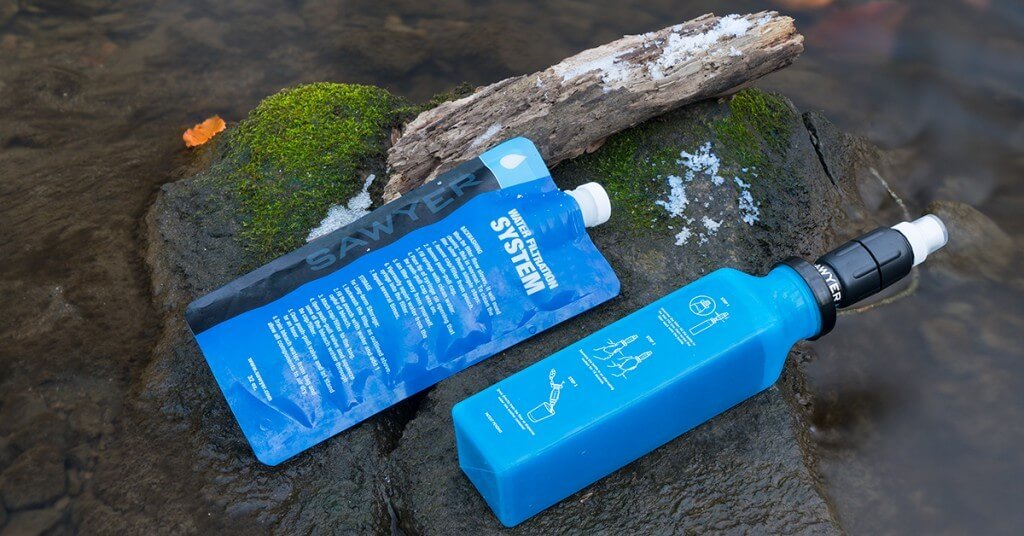
Use instructions are right on the side of the S2 bottle.
Useful Life, Cleaning and Storage
Useful Life
The S2 bottle and foam filler last for 800 uses. That’s about 125 gallons. After that you can replace just the bottle and foam. Note: this is also an upgrade option for Sawyer Squeeze Filter owners.
- Replacement bottle for S1 – MSRP $44.99
- Replacement bottle for S2 – MSRP $64.99
- Replacement bottle for S3 – MSRP $74.99
The Micro Squeeze Filter on top of the bottle has a useful life similar to the Sawyer Mini Filter’s or about 100,000 gallons (with backwashing as necessary).
S2 Bottle – Cleaning and Storage
A surprise, but the bottle and foam inside need no backwashing or sterilization between trips. Just squeeze out the excess water from the foam and stow the bottle covered with either the Micro Squeeze Filter or supplied white cap. That is, it’s best to keep the foam damp while in storage. Proprietary ingredients in the foam prevent bacteria and mold growth or bad smells developing. The S2 Bottle is not damaged by freezing.
Micro Squeeze Filter – Cleaning and Storage
Sawyer’s recommendations for post trip maintenance are the same as for the Sawyer Squeeze Filter. So while not absolutely required, it’s a good practice after trips to backwash the filter, sterilize it with a weak bleach solution and then let it air dry. This will promote filter longevity and maximum flow rates. [Instructions are on the outside of Sawyer Squeeze pouches.]
The Micro Squeeze Filter must be kept above freezing when wet. Water freezing in the filter can destroy the hollow fiber membrane. The easiest way to prevent freezing is to put the filter in a Ziplock bag and keep it in your pants pocket or other warm area during the day. And/or sleep with it at night.
Comparison of the S1, S2 & S3 Water Purifications Systems
The S1, S2 and S3 all have the same components (squeeze bottle, adsorption foam, and Micro Squeeze Filter). What varies is:
- Contaminates removed: S1 removes the least and S3 removes the most including heavy metals.
(The exact formulation of adsorption foam is what controls the contaminates removed) - Useful life: S1 lasts the longest at 1600 uses, and S3 the least at 400 uses.
- Cost: S1 costs the least at $60 & S3 costs the most at $90.
Other Reading
The Best Hydration – Drink When Thirsty
Drink When Thirsty debunks the many myths about hydration and dehydration like “If you are thirsty, it’s already too late” and “If your urine is yellow, you are dehydrated.” This medically sound and well-researched article suggests that Drink When Thirsty is the best and healthiest strategy for hydration during exercise.
Disclaimers
- This post contains affilate links. If you make a purchase after clicking on the these links, a slight portion of the sale helps support this site at no additional cost to you. I am never under an obligation to write page post a review about any product. Finally, this post expresses my own independent opinion.
- The manufacturer provided the author a sample of this product for review.
Drink When Thirsty debunks the many myths about hydration and dehydration like “If you are thirsty, it’s already too late” and “If your urine is yellow, you are dehydrated.” This article suggests that Drink When Thirsty is the best and healthiest strategy for hydration during exercise.
| It turns out that your body’s natural, thirst mechanism (700 million years old) works well to keep you hydrated and healthy during exercise. In fact, the amount of water your body requires is probably far less than what the Sports Drink and Bottled Water companies have been telling us. |
People may be drinking too much water…
With all the hype about the risks of dehydration, it is actually over hydration (hyponatremia) that may be more of a risk. People are now having serious health problems from over hydration for endurance races and even hiking in the Grand Canyon—sometimes resulting in death1,2,3. [Note: Since I first published this post it has been shared by numerous Emergency Medical Treatment and Search and Rescue organizations for this very reason.]
Learn more about choosing between our favorite backcountry filters – Sawyer Squeeze vs Katadyn BeFree vs Platypus Quickdraw and hiking water bottles.
You make Adventure Alan & Co possible. When purchasing through links on our site, we may earn an affiliate commission at no additional cost to you. Here’s why you can trust us.
Best Hydration and Purification System – It’s NOT Complicated!
The simple, inexpensive Hydration and Purification System that Alison and use is shown above. When “drinking to thirst,” it has kept us well hydrated — even between distant water sources in the desert.
Excerpted from my 9 Pound – Full Comfort – Lightweight Backpacking Gear List:
- Sawyer Squeeze Filter: We can drink immediately at water sources. This means both quick, effective hydration and less water to carry when we hike.
- Water Treatment Tablets: For fast, efficient water purification in camp. We can treat 3 or more liters of water in less than a minute. And it’s ready to drink 20-30 minutes later.
Drink When Thirsty – Myths and Facts about Hydration
I recently interviewed three world experts in the field of sports hydration (not affiliated with Sports Drink and Bottled Water companies)
- Dr. Marty Hoffman, MD, founding member of the Foundation for Medicine & Science in Ultra-Endurance Sports, a member of the Wilderness Medical Society, and professor at the University of California Davis
- Dr Tamara , D.P.M., Ph.D., Associate Professor of Exercise Science, Oakland University, Rochester, MI
- Dr. Kristin Stuempfle Ph.D, Professor, Health Sciences, Gettysburg College
This is what I learned from these experts…
Myth1 – If you are thirsty, it’s already too late
Correct – Drink When Thirsty
- All the experts in sports hydration I talked with adamantly agreed that Drink When Thirsty is the best and healthiest strategy for hydration during exercise*.
- As Dr. Hoffman’s puts it: “Drink When Thirsty works for prolonged exercise. Our bodies have a fine tuned feedback system that lets us know when to drink…there is no real danger of dehydration when people have access to water. Thirst kicks in, and people drink.”
- This agrees with the recommendation from the Statement of the Third International Exercise-Associated Hyponatremia Consensus Development Conference, 20154 to Drink When Thirsty; “Using the innate thirst mechanism to guide fluid consumption is a strategy that should limit drinking in excess and developing hyponatremia [over-hydration with significant health consequences] while providing sufficient fluid to prevent excessive dehydration.”
- Excessive drinking when you are not thirsty increases the risk of hyponatremia, arguably a greater risk than dehydration.
*Dr. Tamara Hew-Butler says the natural thirst mechanism has been working in animals and keeping them well-hydrated for at least 700 million years. See more from Dr. Hew on how the human thirst mechanism works.
So why have we been told to drink, drink, drink?
Why do we continue to hear sayings like, “hydrate or die,” “if you are thirsty, it’s already too late,” and stating that “your athletic performance will drop if you don’t drink enough“?
Deborah Cohen, investigations editor for the BMJ [formerly British Medical Journal], wrote up her findings in the 2012 feature article, “The truth about sports drinks5“. This article implies that the sports drinks industry has dramatically increased sales of their products by:
- Creating a “disease of dehydration”
- Stating that the natural thirst mechanism is inadequate to keep athletes hydrated. [Cohen implies that the evidence for this view is lacking.]
- And that this “lack of evidence” is in part due to the close financial and other affiliations between the sports drink companies and the scientists/researchers and supporting institutions that produce the research to support this view.
- Cohen’s article gives examples of studies supporting the sport drink companies claims, that when reviewed by an independent panel of experts, are not deemed robust enough to support those claims.
Here are some excerpts from the article
“Sports drinks are increasingly regarded as an essential adjunct for anyone doing exercise, but the evidence for this view is lacking. Deborah Cohen investigates the links between the sports drinks industry [e.g. Powerade (Coca-Cola) and Gatoraide (PepsiCo)] and academia that have helped market the science of hydration.”
‘“The problem was industry wanted to sell more products so it had to say that thirst was not adequate,” Noakes [Professor Tim Noakes, Discovery health chair of exercise and sports science at Cape Town University] says.’
| ‘Disease mongering is a well documented phenomenon in healthcare6 and Noakes suggests that industry has followed a similar pattern with dehydration and exercise.
“When industry wanted to sell more product it had to develop a new disease that would encourage people to overdrink,” he said adding: “Here’s a disease that you will get if you run. Here’s a product that is going to save your life. That’s exactly what they did. They said dehydration is a dreaded disease of exercise.”’ |
Debunking Other Hydration Myths
The following debunks:
- You need to drink a liter per hour
- Dehydration is a big problem
- If your urine is yellow you are dehydrated
- Dehydration causes cramping
And finally it address the Big Question, “How much water should I drink/carry on a hike?”
Myth2 – You need to drink a liter per hour
Correct – Drink When Thirsty
- Again, Drink When Thirsty is the best strategy.
- Dr. Kristin Stuempfle says that studies7 show that the human body can only process a maximum of 0.8 liters (27 oz) to 1 liter (34 oz) of water at rest. That is not what your body needs—just the maximum amount of water it can process if needed—an important distinction.
- That maximum amount of water processed will go down during exercise. According to Dr. Stuempfle our body’s natural response to exercise is to shunt blood from the kidneys and the GI (stomach and intestines) and put it toward motor (leg) muscles, heart, and skin (cooling). In addition, during exercise the body secrets a natural antidiuretic hormone (ADH) to slow urine output. All these combine to reduce your body’s ability to process water.
- So if you drink more water than you need during exercise (i.e. not drinking to thirst) then your body is receiving more fluids but has less capacity to handle them. Thus the risk of overhydration, and possibly hyponatremia.
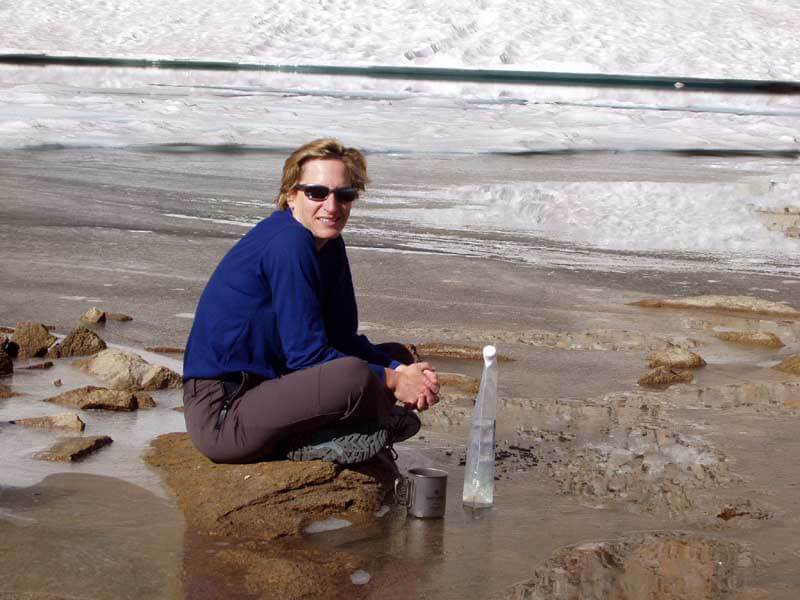
In cooler environments where water is plentiful you may not need to carry any water with you. Drink from the source, and you will likely not be thirsty when you reach your next water source.
Myth 4 – Dehydration is a big problem
Correct – Mild dehydration is not a cause for serious concern
- It will not significantly impair performance or health
- Dr Hoffman told me: “Even a mild hydration deficit of 2-3 liters is OK (provided you were adequately hydrated at the start of your hike). You may not be happy about it, but it’s not a serious problem.“
- Dr Hoffman also told me: “Top ultra runners are still performing well late in the race [100 miles] with a few percent bodyweight loss. They could not perform as well as they do, if percent bodyweight loss and mild dehydration was a big impediment to race performance8,9.”
Myth 5 – If your urine is yellow you are dehydrated
Correct- Urine naturally turns yellow during exercise, even when adequately hydrated
- Dr Hoffman says that: “Trying to keep urine clear during exercise will cause over hydration.” There was complete agreement among all the researchers on this point.
- Additionally Dr Hoffman said: “[during exercise] urine color is not useful, and should not be used, as an indicator of hydration status…During exercise, because of hormonal influences to retain fluid and blood flow being shunted away from the kidney, urine production should be diminished, so urine color will darken.”
- And from Cohen’s article5: “The science of dehydration has led to another widely held belief that is not based on robust evidence—that the colour of urine is a good guide to hydration levels.” And also from Cohen’s article5: “There is a lack evidence for the widely recommended practice of assessing hydration status by looking at the colour of urine,” it suggests.
Myth 6 – Dehydration causes cramping
Correct – Cramping well understood but not likely from dehydration or electrolyte levels
- All the researchers I spoke with agreed that cramping is complex, not well understood and likely has multiple causes.
- They also agree that dehydration and electrolyte depletion are not likely the main causes.
- Dr. Hoffman not only noted that cramping appears to be neuromuscular, but that dehydration or electrolyte depletion does not cause cramping. Dr. Hoffman said this finding has been known for a number of years. In fact, cramping has more to do with neuromuscular nerve misfiring—nerves sending a false signal to muscles to contract and stay contracted, as indicated in research10 by Martin P Schwellnus, UCT/MRC, Research Unit for Exercise, Science and Sports Medicine, Department of Human Biology, Faculty of Health Sciences, University of Cape Town, South Africa.
- From the New York Times Article A Long-Running Mystery, the Common Cramp by By GINA KOLATAFEB. 14, 2008:
- “DR. SCHWELLNUS proposes that the real cause of cramping is an imbalance between nerve signals that excite a muscle and those that inhibit its contractions. And that imbalance, he said, occurs when a muscle is growing fatigued.”
- “There’s the dehydration proposal: you just need more fluid. But, Dr. Schwellnus said, he studied athletes who cramped and found that they were no more dehydrated before or after a race than those who did not have cramps.”
How much water should I Drink/Carry on a hike?
This is the big challenge for backpackers, day-hikers or others that need to carry enough water between distant sources. Unlike Dr. Hoffman’s “There is no real danger of dehydration when people have access to water,” there is a possibility that if we don’t carry enough water between distant sources that we could run out of water and potentially become dehydrated. On the other hand, if we are hiking a long distance between water sources and and decide to carry 5 liters of water we are carrying an additional 11 pounds. This too has serious downsides.
So the big question for hikers and backpckers is
How do you estimate the “right” amount of water to carry between distant sources? |
The goal is homeostasis, or to drink the same amount of water as your body uses. But how do we estimate our personal water consumption needs for homeostasis in the field? There is likely no “right or exact” answer to this. Dr. Stuempfle and Dr. Tamara Hew-Butler agree that the following would be a reasonable strategy for individuals to estimate their personal water consumption in the field:
- On test day-hikes (or a weekend backpacking trip), Drink When Thirsty and record the amount of water your drink per hour. Try to do this close to the same level of exertion, and temperature and humidity that you will expect on your backpacking trips (or long day hikes).
- Use this consumption rate per hour as a starting point for estimating the amount of water you’ll need to carry between distant sources in the field for your longer and more serious trips.
- It is best to be conservative (carry a bit more water) until you have tested out and fine tuned your personal water consumption rate over at lest a few longer trips in the field.
- Obviously if it is hotter, more humid, you are working harder, or your pack is heavier, you may need more water per hour. But, if it is cooler, less humid, or you are not working as hard, you may need less water per hour.
On a personal note, when following Drink When Thirsty I frequently do not carry any water with me in the field (Sierras, Appalachian Trail, etc.). When I drink (using aSawyer Squeeze Filter so I can drink directly at the source), I find that I am unlikely to be thirsty until I reach the next water source. My wife seems to run a bit thirster, and in addition to drinking at water sources, she usually carries somewhere between ½ to ¾ of a liter between sources.
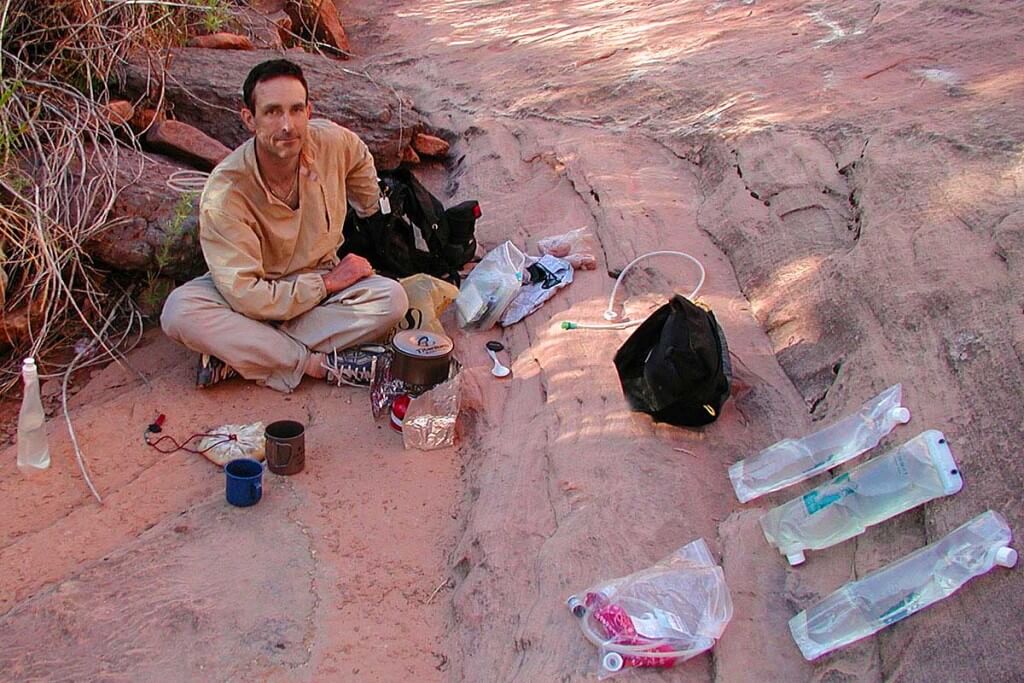
Although I rarely carry water with me, the desert is the exception. This picture is from a drought year in the Southern Utah desert. So an unusually dry time in an already hot and dry place. I have collected a lot of water: for dinner that evening, breakfast the next morning & to carry during the day to our next reliable water source.
The only place we carry large amounts of water between sources is in the Desert Southwest, like Canyoneering in Utah. But even then, following Drink When Thirsty, we carry less water than the “recommended” amounts in guide books and other “authoritative” sources. We pull long days in the desert and feel healthy and fine. But we have years of field experience and comfortably know our personal water needs in the desert.
How the natural thirst mechanism works
Dr Tamara Hew-Butler, who has studied the natural thirst mechanism in animals, says it’s been working to keep them well-hydrated for at least 700 million years. The human thirst mechanism functions in two ways:
- Brain sensing electrolyte levels11: Your brain has real-time osmosensors that monitor sodium concentrations (more specifically, the amount of osmoles, for which sodium makes up the greatest amount) circulating in the blood. When sodium levels start to rise above normal, your body has a two stage response. The first response, is to slow urine output and therefore water loss (this occurs before thirst is triggered). If sodium levels continue to rise, your thirst mechanism kicks in and you become thirsty. It is important to note that you are NOT dehydrated at this point. All this happens before dehydration becomes an issue. This is your body’s normal mechanism to keep you from getting dehydrated. Dr. Hoffman and Dr. Hew-Butler both point out that as long as folks have access to water, their thirst will cause them to drink and not become dehydrated.
- Your heart (actually the main valves) senses blood volume (water): Your heart valves have barorreceptors that can detect a reduction in blood volume (water in the body). This also has a two stage response just the same as the brain’s osmosensor responses. Stage 1 happens at an 8-10% blood volume depletion and triggers an anti-diuretic hormone release which slows urine output and therefore water loss. You are not thirsty at this point. If blood volume continues to decrease, your thirst mechanism kicks and you get thirsty. Again note: that you are NOT dehydrated at this point. All this happens before dehydration become an issue. This is your body’s normal mechanism to keep you from getting dehydrated.
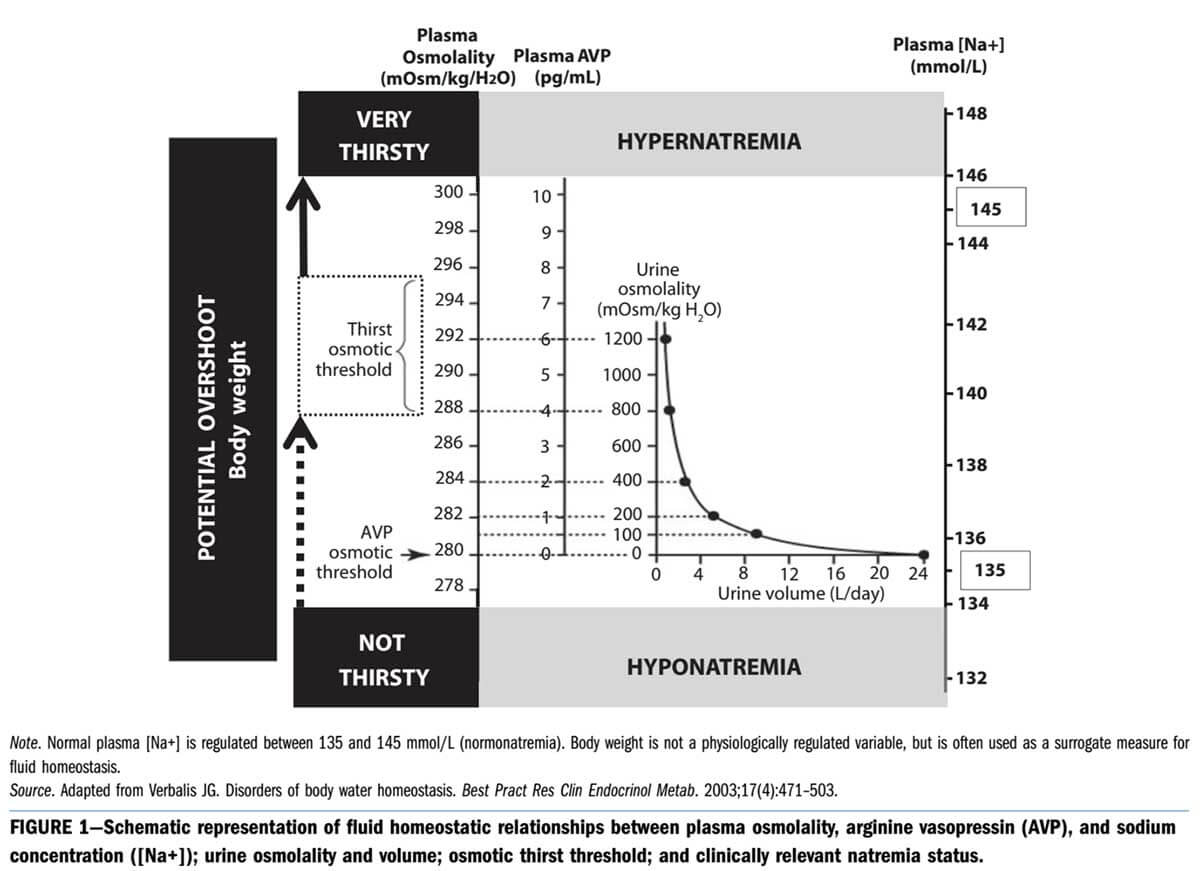
Figure source: 11 – INADEQUATE HYDRATION OR NORMAL BODY FLUID HOMEOSTASIS? – Tamara Hew-Butler, PhD, LETTERS, American Journal of Public Health, October 2015, Vol 105, No. 10, page e6
Summary
Drink When Thirsty, it’s been keeping hominoids well hydrated for millions of years.
References
1 Three Cases of Severe Hyponatremia During a River Run in Grand Canyon National Park – Emily A. Pearce, BS, et al., WILDERNESS & ENVIRONMENTAL MEDICINE, 26, 189–195 (2015)
2 Hiker Fatality From Severe Hyponatremia in Grand Canyon National Park – Thomas M. Myers, MD, et al., WILDERNESS & ENVIRONMENTAL MEDICINE, (2015)
3 Exercise-associated hyponatremia with exertional rhabdomyolysis: importance of proper treatment – Martin D. Hoffman1, et al., Clinical Nephrology, DOI 10.5414/CN108233
4 Statement of the Third International Exercise-Associated Hyponatremia Consensus Development Conference, Carlsbad, California, 2015 – Hew-Butler, Tamara DPM, PhD, et al., Clinical Journal of Sport Medicine: July 2015 – Volume 25 – Issue 4 – p 303–320, doi: 10.1097/JSM.0000000000000221
5 The truth about sports drinks – Deborah Cohen investigations editor, BMJ 2012;345:e4737 doi: 10.1136/bmj.e4737 (Published 18 July 2012)
6 Moynihan R, Heath I, Henry D. Selling sickness: the pharmaceutical industry and disease mongering. BMJ 2002;324:886.
7 Peak rates of diuresis in healthy humans during oral fluid overload – Noakes TD, et al., 2001 Oct;91(10):852-7. PMID:11732457
8 Race Diet of Finishers and Non-Finishers in a 100 Mile (161 km) Mountain Footrace – Kristin J. Stuempfle, PhD, Martin D. Hoffman, MD, Journal of the American College of Nutrition, Vol. 30, No. 6, 529–535 (2011) page 529
9 Association of Gastrointestinal Distress in Ultramarathoners With Race Diet – Kristin J. Stuempfle, Martin D. Hoffman, and Tamara Hew-Butler, International Journal of Sport Nutrition and Exercise Metabolism, 2013, 23, 103 -109
10 Cause of Exercise Associated Muscle Cramps (EAMC) — altered neuromuscular control, dehydration or electrolyte depletion? M P Schwellnus, British Journal of Sports Medicine 2009 43: 401-408 originally published online November 3, 2008 doi: 10.1136/bjsm.2008.050401
11 INADEQUATE HYDRATION OR NORMAL BODY FLUID HOMEOSTASIS? – Tamara Hew-Butler, PhD, LETTERS, American Journal of Public Health, October 2015, Vol 105, No. 10, page e5
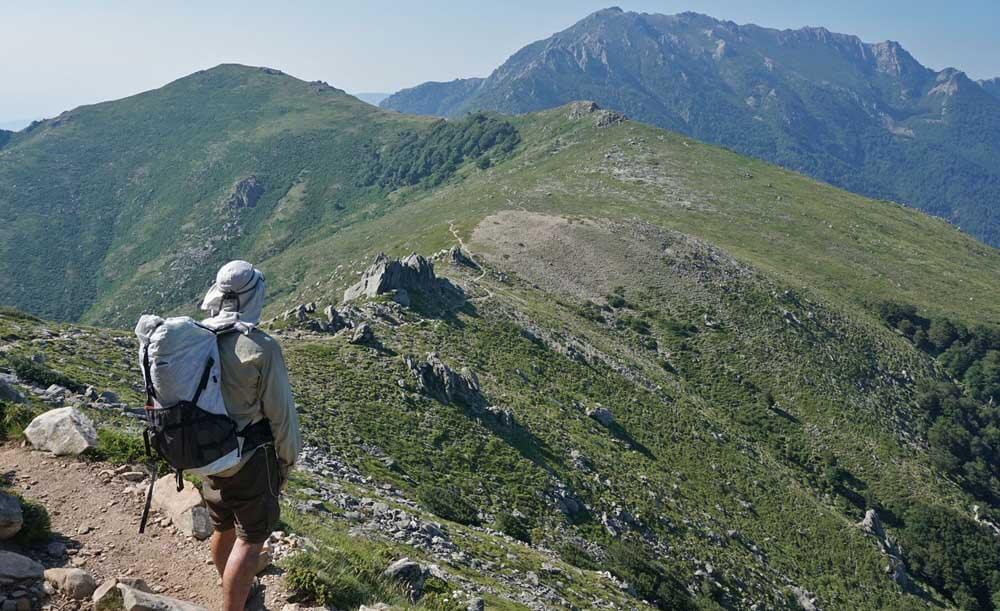
Moving fast and light along the spectacular ridge line of the GR20 in Corsica. A minimal pack (and good pre-trip training) enabled Alison and I to do a 16 day trip in under 8 days. Pictured – the award winning Hyperlite Mountain Gear 2400 Southwest Pack
You make Adventure Alan & Co possible. When purchasing through links on our site, we may earn an affiliate commission at no additional cost to you. Here’s why you can trust us.
Quick ways to reduce backpack weight. A few may surprise you…
- Look at The Big Three: Backpack, Tent/shelter, and Sleep System (sleeping bag, sleeping pad, and ground cloth). You stand to lose a bunch of weight from these: as much as 10 to 12 pounds.
- Take a Backpack that weighs less than two pounds. See our: Best Backpacks for Backpacking and Hiking
- Take a Tent that weighs less than two pounds. See our: Best Backpacking Tents | Lightweight & Ultralight
- Take a Sleeping bag that that weighs less than 1.5 pounds. See our: Buyers Guide to Lightweight Backpacking Quilts & Sleeping Bags
- Look at our 9 Pound Full Comfort Lightweight Backpacking Gear List for more ideas for gear to save weight.
Nine pounds of backpacking gear is all a hiker needs to be safe and warm. Or simply put, this list has better backpacking gear. For over a decade it’s been tested, refined, and updated to reflect only the best and most current backpacking gear now available in 2019. So, if you want to reduce pack weight without reducing comfort, look no further! The hiking gear in this guide is suitable for all 3-season conditions on trips around the world, from Alaska, to Patagonia, to Utah.
- Look on The Backpacking Food Page to save a ton of weight at zero cost
- Get a weather report (the NOAA hourly weather graph is among the most informative and accurate)—then pack for those conditions! Since 90% of backpackers take 90% their trips for 3 days or or less, this weather report should be quite accurate for the short time you are out. This will let you pack a tent, clothing, and sleeping bag appropriate for actual conditions. It will also deter you from taking inappropriate, “what-if-the-worst-happens!” gear, e.g. 6 pound tent, and a +10F sleeping bag for a balmy weather trip on the Appalachian Trail.
- Don’t take extra clothing. e.g. don’t take any more clothing than you can wear at one time.
- Take less: Be disciplined and leave a few items at home that you haven’t used in the last three trips. Put stuff like sunscreen and trail soap in smaller containers.
- Extra Credit: Browse The Gear Lists Page for other ideas and examples to save weight. This will give you a good examples of what type of gear is available and what is a reasonable weight for that type of gear, e.g. around 6-8 ounces for a rain jacket, or around 1.0 ounce for a pocket knife. Think hard if your gear is 2 to 3x heavier than the examples on these lists.
- Read my The Best Hydration — Drink When Thirsty. Use a Sawyer Squeeze Water Filter to drink at the source (lake, stream, etc.). Then only carry a sensible amount to get to your next known water source. I.e. it makes no sense to carry 3 liters of water, almost 7 pounds, when your next water source is only two hours away.
- Remember to have fun! That will at least, lighten your spirit and mood.
How Do I Start?
- Ground yourself in reality: Get all your stuff together and weigh it. If you’re like most conventional hikers, your equipment will weigh around 30 pounds, possibly higher.
- Get individual weights for your heavier items like tents and backpacks. For stuff in the range of a few pounds or less you’ll want to buy an inexpensive digital scale that weighs up to 10 pounds.
- See what you can leave at home. Anything you don’t bring is free weight reduction. Think hard about this one. Do you really need it?
- Put together a spreadsheet (or at least a list) with all your equipment weights. This is an indispensable analysis tool.
- Try to figure out where you’ll get the most “bang for the buck.” e.g. figure out how much a new item costs and divide that by the amount of weight it will save you over your old equipment. Target the items that give you the most weight loss for the fewest dollars.
- Buy on Sale: Don’t try to purchase all your new equipment right away. Many items regularly go on sale or are closed out. Watch carefully over the course of a year and you could save 30 to 70 percent on your equipment.
© Jaeger Shaw, Sustain Succeed LLC, and AdventureAlan.com, 2000-2023 | All Rights Reserved
Unauthorized use and/or duplication of this material without express and written permission from this site’s owner is strictly prohibited. Brief excerpts and links may be used freely without express and written permission, provided that full and clear credit is given to AdventureAlan.com with appropriate and specific direction linking to the original content.
You make Adventure Alan & Co possible. When purchasing through links on our site, we may earn an affiliate commission at no additional cost to you.
Affiliate Disclosure | Privacy Policy | Terms and Conditions | Contact Us

